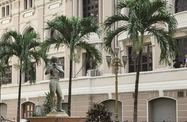Strong domestic demand and record high foreign investment inflows underpinned the continued rapid growth of the Vietnamese economy in 2016.

According to data issued by the Government Statistics Office (GSO), GDP expanded by 6.2% in 2016, just shy of the government’s projection of 6.3% and slightly above the IMF’s estimate of 6.1%.
While this was the first time in four years that growth had slowed – from 6.7% in 2015 – per capita GDP rose 5% to a new high of $2215.
Farming underperforming
This strong rate of growth came despite weakened returns from the agriculture sector, which saw yields reduced due to adverse climatic events. Drought conditions, the worst in some 30 years, impacted coffee and rice production, while flooding in some regions eroded rice harvests.
Environmental factors, combined with lower commodity prices in some markets, saw agriculture’s growth trimmed to 1.36% for 2016, its lowest since 2011. The main factor at play in the downturn was a decrease in the volume and value of rice exports, which fell by 25.8% and 21.2% to 4.88m tonnes and $2.2bn, respectively.
Credit up, inflation flat
The strong rate of economic expansion was also reflected in bank lending, with credit growth hitting 21.82% for the year, slightly higher than the estimate of between 18% and 20% from the State Bank of Vietnam (SBV).
If maintained into 2017, high levels of lending could see the SBV move on rates to take some of the heat out of demand in the economy. Le Minh Hung, the governor of SBV, reiterated this at the end of December, when he told local press that the bank could raise its key interest benchmark to keep inflation and economic expansion balanced.
An even economic footing was successfully maintained in 2016, as while GDP growth came in marginally below targeted levels, inflation also rose at a slower rate than predicted. Vietnam’s consumer price index rose 2.66% in 2016, well down on the 5% increase forecast by the government.
However, pressure might be exerted on the index in 2017, as price rises gained momentum late in the fourth quarter of last year, with December’s consumer price index pushed up by increases in medical and education costs to 4.74% y-o-y, according to GSO data. Despite this jump, the government has projected inflation of 4% for 2017.
One factor helping keep inflation in check was the stability of the local currency, with the dong only depreciating by 1.2% against the dollar throughout the year. Unlike a number of emerging economies, which saw sharp falls in the value of their currency push up the cost of imports, Vietnam’s dong maintained a steady course.
For example, following the US presidential election in late November, Malaysia’s ringgit fell by 6.5% to a 19-year low against the dollar, while Indonesia’s rupiah depreciated by roughly 2%.
FDI raises bar
Investor appetite remained strong through 2016, with foreign direct investment (FDI) rising sharply.
Actual foreign investment inflows rose by 9% last year, reaching a record high of $15.8bn, according to data issued by the Ministry of Planning and Investment at the end of the year. Additional funds for existing investment projects and new FDI commitments combined to total $24.4bn – an increase of 7% on the 2015 figure.
The main beneficiaries of FDI were the manufacturing and processing sector, which accounted for 63.7% of all inbound investments; the automotive wholesale, retail and repair sector with 7.8% of the total; and real estate with 6.9%.
Prospects for growth this year remain strong, with the IMF predicting GDP to rise by 6.2%. This forecast is supported by macroeconomic indicators from the fourth quarter, when GDP rose 6.68% y-o-y, according to GSO data, up from 6.56% in the preceding three months. This increasing pace of expansion, combined with more favourable conditions for the agricultural sector, should sustain growth in 2017.


